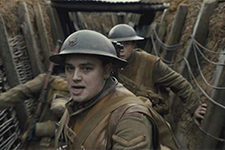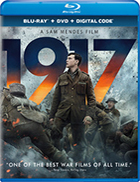1917
|  Sam Mendes’s 1917 is a gripping, harrowing portrait of war that is made all the more compelling by its tight narrative and temporal focus. Set during World War I in northern France in early April 1917, the narrative is centered on a single mission assigned to two young British soldiers: leave their regiment and carry a message across No Man’s Land to the 2nd Battalion of the Devonshire Regiment, which is planning an ambush on what they think are desperately retreating German forces the next morning. However, aerial surveillance has determined that the German retreat is not desperate at all, but is rather a coordinated fallback to a better defensive position, meaning that the British soldiers are, rather than ambushing the Germans, about to be ambushed themselves, which will result in their wholesale slaughter. The two men carrying the message are Lance Corporal Schofield (George MacKay) and Lance Corporal Blake (Dean-Charles Chapman), the latter of whose older brother is in the Devonshire Regiment. Thus, the mission has a personal urgency for him, as he literally holds his brother’s life (along with the lives of 1,600 other British soldiers) in his hands. He selects Schofield to accompany him, not knowing that they will be asked by General Erinmore (Colin Firth) to take on a dangerous mission with such grave, life-and-death consequences. Their trek, which they must complete in less than 24 hours, involves them leaving the relative safety of the British trenches and making their way first through the No Man’s Land between their trenches and the German trenches (which they think are deserted, but may not be) and then through many miles of open country where they have no idea what they will encounter. Thus, we are essentially thrown in with Blake and Schofield as they move from one perilous situation to another; every tunnel, every trench, every open field, every bombed-out building presents them with new dangers and threats, and Mendes manages the tension with Hitchcockian verve and nuance. Speaking of Hitchcock, I have yet to mention 1917’s most prominent aesthetic characteristic, which is that Mendes and cinematographer Roger Deakins shot the film so that it appears to be one continuous take, an approach that Hitchcock experimented with in Rope (1948). Of course, Rope unfolded in real time in a single setting (an apartment), whereas 1917 takes place over a much lengthier period of time and covers miles and miles of space. Mendes and Deakins, who previously collaborated on Jarhead (2005), Revolutionary Road (2008), and Skyfall (2012), use the same trick Hitchcock did to disguise various cuts by having the camera move behind an object or into a space of darkness (they also have the benefit of shooting digitally, which allows them to make much longer single takes, whereas Hitchcock was limited by the length of a standard 35mm roll of film). However, such technicalities are ultimately just that, and what really matters is the cumulative effect, which is one of constantly unfolding real space and time that heightens the film’s intensity of feeling, not to mention the disquiet of its violence. The one-take thing is a gimmick, sure, but one that is so thoroughly and thoughtfully interwoven with the film’s narrative flow that you cease to notice it after the first few minutes, which is really the best thing one can say about it. It works to draw you in and keep you there. While 1917 is a war movie, it is more accurate to think of it as a suspense-thriller set against the backdrop of war. There is nothing overtly political about the film, and Mendes and co-screenwriter Krysty Wilson-Cairns (Penny Dreadful) make no effort to address the causes of the war itself because they are ultimately irrelevant to the film’s focus on the plight of its beleaguered young protagonists. The story could have been set against the backdrop of almost any war; Mendes chose World War I because his grandfather had told him stories about his experiences as a soldier in that war, including one similar to the plot here. The story unfolds against an uncanny, at times surrealistic landscape, scarred and made horrific by the ravages of bombs and grenades and bullets and fire (one of the film’s most striking images is a large space behind the German trenches that is filled with tens of thousands of shell casings, piled into small mountains of dull brass). Filmmakers from Lewis Milestone, to Stanley Kubrick, to Andrei Tarkovsky, to Terrence Malick, to Steven Spielberg have recognized the uniquely strange visual nature of a land scorched by war, and Mendes and his regular production designer Dennis Gassner (who has also worked extensively with the Coen Brothers) take that mantle and runs with it, presenting us with a forceful procession of landscapes adorned with shattered human bodies that remind us of how the horrors of war befall all life on earth. The film’s only real lull is when Schofield temporarily finds respite in a bombed-out village with a young French woman who is tending to a baby that is not her own. There is a sense that Mendes wants to slow things down a bit and remind us of the humanity that is at stake and the innocents who become collateral damage when nations turn to mass bloodshed, but it feels a bit too cliché and on the nose. Much better is the way he opens and closes the film with the characters set against a lush, grassy field, which effectively bookends the violence and destruction and death with a symbolic reminder that beauty persists, even in the worst of times.
Copyright © 2020 James Kendrick Thoughts? E-mail James Kendrick All images copyright © Universal Pictures Home Entertainment | |||||||||||||||||||||||||||||
Overall Rating: 


 (3.5)
(3.5)


